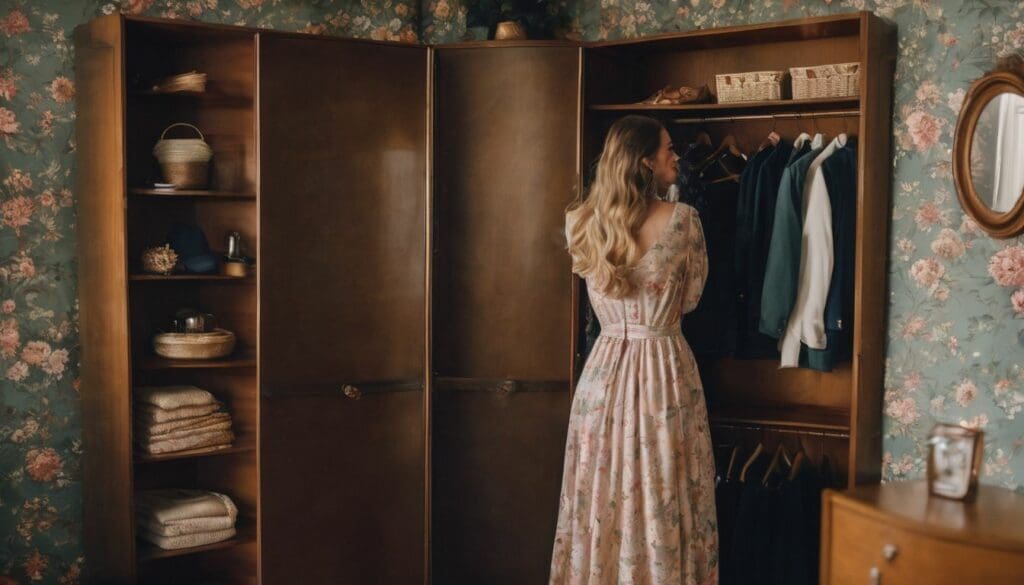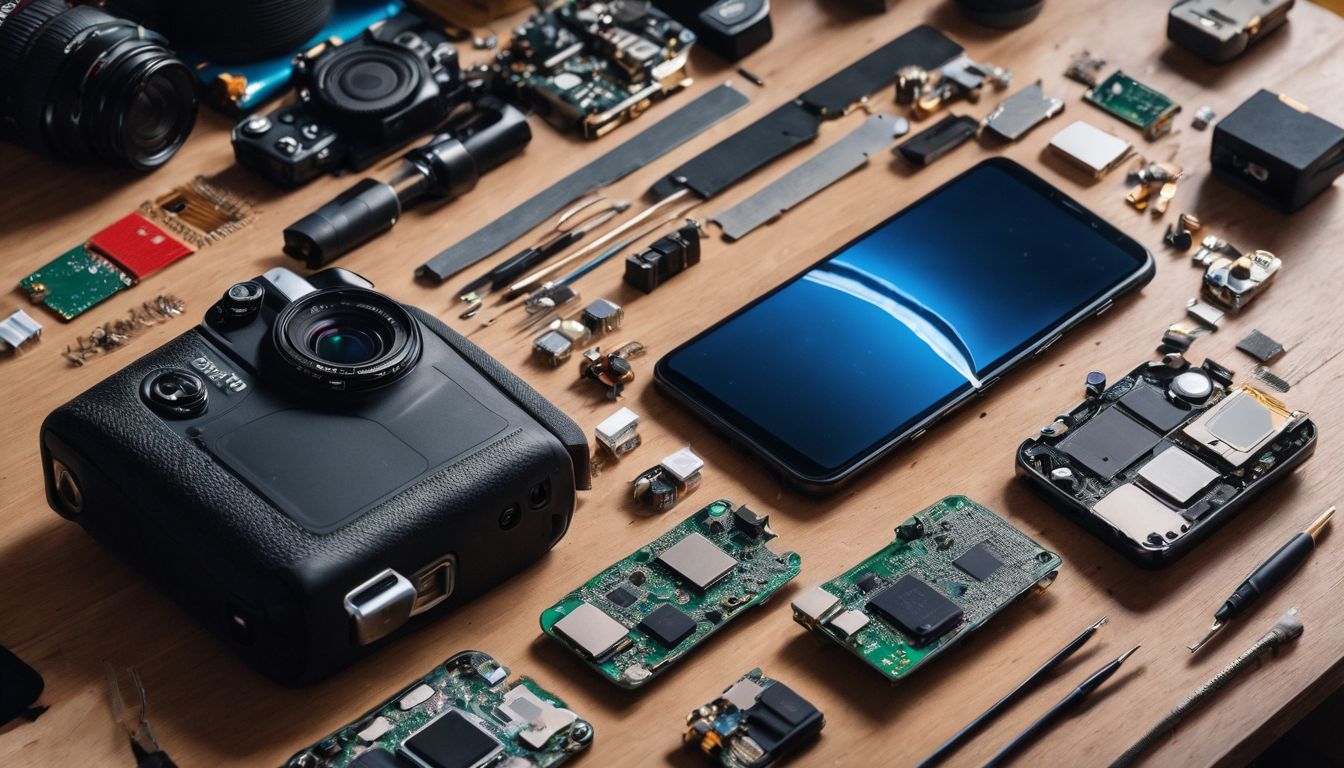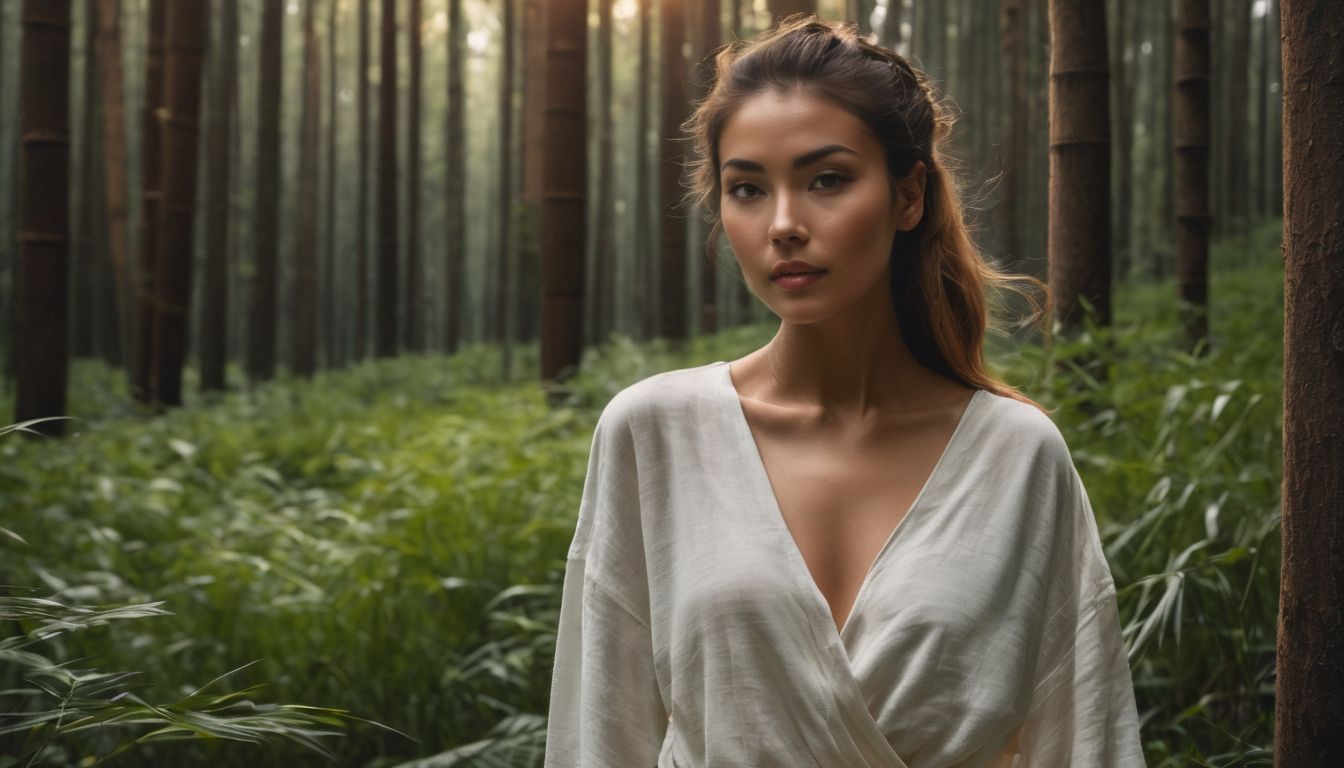Feeling swamped by the relentless march of buy-and-bin fashion? You’re not alone in that boat. It’s exactly why we’re championing a movement that marries style with sustainability.
Generation Z has fanned the flames of a second-hand fashion revolution, breathing new life into once-loved pieces and filling our wardrobes with them. Let us guide you through the artistry of second-hand chic; your next beloved ensemble might just be nestled among the treasures of a thrift shop.
Read on to discover how pre-loved fashion can cast its enchanting spell over your sartorial choices!
Key Takeaways
- Thrifting helps spot unique bargains such as high – quality materials and designer labels, contributing to a sustainable wardrobe that stands out.
- Vintage and secondhand stores offer one-of-a-kind items from different eras, enabling shoppers to express their individuality while supporting eco-friendly fashion.
- Upcycling old clothes breathes new life into them, allowing personal creativity to shine through customised fashion pieces that reduce waste.
- Building a connection with the past through vintage clothing brings history into modern wardrobes, creating timeless styles that are both stylish and environmentally conscious.
- Industry leaders are endorsing thrifting and upcycling, making secondhand shopping increasingly mainstream as part of a sustainable fashion movement.
The Art of Thrifting: Tips for Finding Great Finds
When it comes to thrifting, spotting valuable bargains is all about knowing what to look for. From unique vintage pieces to high-quality secondhand items, consignment, thrift, and vintage stores are treasure troves waiting to be explored.
So let’s dive into the world of thrifting and discover how you can find great fashion finds while shopping sustainably.
How to spot valuable bargains
We know the thrill of the hunt is part of what makes thrifting so appealing, especially when you manage to snag a piece that’s both unique and valuable. To spot those hidden bargains, pay close attention to quality indicators like fabric, construction, brand labels, and overall condition.
High-quality materials like real leather or silk are usually signs of a worthwhile find. Check for designer tags as well but be aware of knock-offs; authentic luxury items will have consistent stitching and logos.
Expertise comes with experience—so keep an eye out for timeless fashion pieces that stand out from generic retail clothing. Look for vintage styles that circle back into trend; they’re often more durable and distinctive than modern fast fashion counterparts.
Remember, our ecofriendly wardrobe choices not only elevate personal style but also contribute positively towards sustainable shopping practices.
Shopping in consignment, thrift, and vintage stores
When shopping in consignment, thrift, and vintage stores, we can find unique and one-of-a-kind items that are not available in traditional retail stores.
Reviving the Past: Rocking Retro Looks with Upcycled Clothing
Embracing unique styles from the past is all about rocking retro looks with upcycled clothing. Upcycling gives new life to old clothes, allowing you to create a one-of-a-kind wardrobe that’s both stylish and sustainable.
Embracing unique styles from the past
Discovering and embracing unique styles from the past has become a captivating trend, with vintage clothing making a strong comeback in fashion. Reusing and reviving retro looks not only adds individuality to your wardrobe but also contributes to sustainable fashion practices.
Retro fashions allow for experimentation with diverse styles while reducing the environmental impact caused by fast fashion. Furthermore, upcycling and breathing new life into old garments is an excellent way to express personal style while honouring the craftsmanship of previous eras.
The resurgence of vintage clothing demonstrates a shift towards appreciating quality over quantity, as well as acknowledging the value of reusing materials. As passionate gamers or novice gamers interested in sustainable living and expressing unique style, delving into vintage clothing can provide an opportunity to build a more eco-friendly wardrobe without compromising on personal flair.
Upcycling and giving new life to old clothes
Embracing unique styles from the past, we can take a step further in sustainable fashion by upcycling and breathing new life into old clothes. This process involves transforming worn-out or outdated clothing into fresh, trendy pieces with a personal touch.
By learning simple sewing techniques or working with local tailors and designers, anyone can transform old garments into something unique and stylish. Not only does upcycling reduce waste and extend the lifespan of clothing, but it also allows for creative expression through fashion.
Furthermore, embracing upcycling provides an opportunity to showcase individuality by creating one-of-a-kind items that reflect personal tastes and values. Adding small details like patches, embroidery, or altering cuts can transform old clothing into stylish new creations that tell a story while contributing to a more sustainable wardrobe.
Green Fashion: The Benefits of Sustainable Shopping
Reducing waste through thrifting and vintage shopping is not only environmentally friendly but also a way to build a connection with the past. Creating a sustainable wardrobe filled with unique, secondhand pieces is a great way to embrace green fashion.
Reducing waste through thrifting
Thrifting reduces waste by giving pre-loved items a second lease on life. By purchasing second-hand clothing, we help divert textiles from ending up in landfills and contribute to a more sustainable fashion industry.
Generation Z’s embrace of thrifting has brought attention to the environmental benefits of buying vintage and pre-loved fashion. Embracing secondhand clothing helps us reduce our carbon footprint and limit the environmental impact caused by fast fashion.
Thrift shopping not only offers unique finds but also aligns with eco-friendly values, making it an impactful choice for building a more sustainable wardrobe.
Thrift shopping presents an opportunity for individuals to support circular fashion practices which promote sustainability. Choosing vintage or second-hand clothing over new garments reduces the demand for virgin materials, lessening the strain on natural resources while helping preserve our planet’s ecosystems.
The shift towards thrifted and vintage items reflects a conscious effort to minimise waste, contributing positively to reducing the environmental burden associated with textile production and consumption.
Building a connection with the past
Building a connection with the past through secondhand clothing is an opportunity to embrace history and unique styles. Vintage items carry their own stories, evoking a sense of nostalgia whilst providing a distinctive fashion statement.
By exploring retro looks and upcycling old garments, individuals can build a sustainable wardrobe that reflects their love for preloved fashion. Embracing vintage clothing not only allows for creative expression but also contributes to reducing waste by giving new life to old pieces.
The resurgence of thrifting has allowed for the resurrection of forgotten styles, offering a gateway to connect with iconic fashion eras while promoting eco-friendly practices. Finding hidden gems in thrift stores or consignment shops adds individuality to one’s wardrobe, creating timeless ensembles that pay homage to bygone trends.
Creating a sustainable wardrobe
To create a sustainable wardrobe, consider the benefits of thrifting and vintage clothing. By embracing secondhand fashion, you can reduce waste and build a connection with the past.
Thrifting eliminates the need for new materials and production, making it a more eco-friendly option than fast fashion. Additionally, by choosing pre-loved or upcycled pieces, you can experiment with unique styles while contributing to a more ethical approach to fashion consumption.
Consider incorporating vintage and secondhand pieces into your wardrobe as part of building a sustainable style. Choose quality over quantity when selecting items from consignment stores or thrift shops, aiming for timeless pieces that align with your personal style.
Finding Your Style: Making the Most of Secondhand Clothing
Incorporating vintage and secondhand pieces into your wardrobe can add a unique touch to your style. It’s all about quality over quantity, combining new and old items for a fresh and individual look.
Incorporating vintage and secondhand pieces into your wardrobe
We can easily add vintage and secondhand pieces to our wardrobe to create a unique style that supports sustainable fashion trends and embraces individuality. Choose timeless pieces that complement your existing wardrobe, such as a classic blazer or a statement coat, to elevate any outfit effortlessly.
- Mix and match new and old items for a fresh look. Blend retro pieces with contemporary clothing for a modern twist on vintage fashion.
- Invest in high-quality secondhand items to build a long-lasting and sustainable wardrobe that reduces waste and supports eco-friendly fashion.
- Experiment with different styles from various eras, such as the 70s boho – chic or 90s grunge, to discover your personal vintage aesthetic while reducing the environmental impact of fast fashion.
- Incorporate unique vintage accessories like scarves, hats, or jewellery to add character to your outfits while reducing the demand for newly produced accessories.
- Embrace the thrill of the hunt by exploring thrift stores, consignment shops, and online vintage marketplaces to find hidden treasures that bring charm and history into your style.
Quality over quantity
When it comes to incorporating vintage and secondhand pieces into your wardrobe, prioritising quality over quantity is essential. By selecting well-made pre-loved clothing, you can enjoy timeless style while also reducing the environmental impact of fast fashion.
Embracing sustainable shopping practices not only allows for a unique look but also supports the movement towards a more eco-friendly fashion industry. With Generation Z leading the trend of embracing second-hand clothing, finding high-quality retro items in charity shops has become easier than ever.
Opting for fewer well-crafted vintage pieces over numerous lower-quality items not only helps to cultivate a sustainable wardrobe but also encourages a deeper connection with each piece’s history and craftsmanship.
Combining new and old items for a unique look
When you combine new and old items, you create a distinctive style that reflects your personality. Mixing vintage pieces with modern clothing allows for an eclectic and individualised look.
By adding preloved or thrifted items to your wardrobe, you can create a sustainable fashion statement while exploring unique styles from different eras.
Incorporating secondhand finds into your outfits not only reduces waste but also offers the chance to express yourself creatively. It’s about embracing the past while making it relevant in the present – creating a fusion of styles that is both timeless and contemporary.
The Future of Secondhand: Sustainable Fashion on the Rise
As sustainable fashion practices gain traction, secondhand shopping and vintage clothing are becoming more mainstream. Fashion industry leaders are promoting the benefits of thrifting and upcycling, paving the way for a more eco-friendly and stylish future.
Read on to discover how you can embrace this trend and make a positive impact on the environment while looking chic.
Fashion industry leaders promoting sustainable practices
Fashion industry leaders are driving the movement towards sustainability by embracing eco-friendly practices. They are incorporating upcycled and second-hand clothing into their collections, supporting the shift towards a more sustainable fashion industry.
Retailers and designers are recognising the significance of reducing waste through thrifting and promoting ethical consumption among consumers.
As part of this trend, we witness an increase in collaboration between major brands and charity shops to encourage mindful shopping habits. This partnership is not only influencing seasoned fashion enthusiasts but also attracting newcomers to explore the world of sustainable fashion.
Thrifting and vintage becoming mainstream
With the fashion industry leaders promoting sustainable practices, thrifting and vintage clothing have gained significant traction, reaching a mainstream audience. Generation Z’s enthusiasm for second-hand fashion has driven this trend, drawing attention to the appeal of thrifted and vintage items in the wider market.
Social media influencers have played a pivotal role in normalising and popularising second-hand clothing, encouraging others to embrace preloved, eco-friendly fashion choices. This shift towards sustainability not only aligns with environmental concerns but also offers individuals an opportunity to express their unique style through upcycled and retro pieces.
Conclusion
In conclusion, embracing thrifting and vintage clothing offers a sustainable and eco-friendly way to explore unique fashion. With the popularity of second-hand shopping on the rise, it’s clear that this trend is here to stay.
By incorporating preloved items into our wardrobes, we can make a positive impact on the environment while expressing our personal style. Thrifting and vintage clothing are not just fashion trends; they represent a conscious choice towards sustainability and individuality.
FAQs
1. What does “Secondhand Chic” mean?
“Secondhand Chic” means stylishly wearing preloved clothing bought from thrift stores, consignment shops, or the secondhand market.
2. Why is thrifting seen as a trendy thing to do now?
Thrifting has become trendy because it offers unique retro and vintage clothing options that are eco-friendly and promote fashion recycling.
3. Can you find good quality clothes when shopping secondhand?
Absolutely! Many secondhand style lovers uncover high-quality, fashionable pieces with lots of life left in them through diligent thrifting culture exploration.
4. How does buying secondhand help the environment?
Buying secondhand helps reduce waste by reusing fashion items, cutting down on new production needs and supporting ecofriendly fashion trends.
5. Is vintage clothing only for those who like old-fashion styles?
Not at all! Vintage clothing appeals to anyone who appreciates classic designs, wants to express individuality or add a retro twist to their modern wardrobe.





